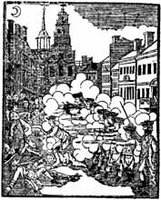“In like manner killed by two balls”
 As discussed yesterday, there’s good evidence that Crispus Attucks was the first person shot at the Boston Massacre.
As discussed yesterday, there’s good evidence that Crispus Attucks was the first person shot at the Boston Massacre.
There’s even stronger evidence that he was hit with two musket balls.
The 12 Mar 1770 Boston Gazette reported that Attucks was “killed instantly; two balls entering his breast one of them in special goring the right lobe of the lungs, and a great part of the liver most horribly."
Dr. Benjamin Church did an autopsy and wrote in even more detail:
I found two wounds in the region of the thorax, the one on the right side, which entered through the second true rib within an inch and a half of the sternum, dividing the rib and separating the cartilaginous extremity from the sternum, the ball passed obliquely downward through the diaphragm and entering through the large lobe of the liver and the gall-bladder, still keeping its oblique direction, divided the aorta descendens just above its division into the iliacs, from thence it made its exit on the left side of the spine. This wound I apprehended was the immediate cause of his death.Church’s main point in all that Latinate anatomy was that “from the oblique direction of the wounds, I apprehend the gun must have been discharged from some elevation”—i.e., from the windows above the soldiers. His deposition was part of the Whigs’ argument that the Customs service was involved in the shooting.
The other ball entered the fourth of the false ribs, about five inches from the linea alba, and descending obliquely passed through the second false rib, at the distance of about eight inches from the linea alba…
But the angle of the musket balls was affected by how Attucks was standing. John Danbrook testified, “The Molatto was leaning over a long stick he had, resting his breast upon it.” With Attucks leaning forward, musket balls shot level into his chest would probably have exited at lower points on his back.
Danbrook and other witnesses agreed that Attucks fell quickly after the first musket shot, before they heard another gun fire. He didn’t continue standing long enough to be shot by a second gun. That strongly suggests he was hit by two musket balls at once, both coming from one discharge.
I’ve previously noted how Edward Crafts reported Cpl. Hugh McCann telling him that on a British army patrol that night “every man [was] loaded with a brace of balls.” There are many other examples of muskets reported to fire two balls at once in this period.
It’s also significant that the coroner’s jury decided that Attucks was killed by “the discharge of a Musket or Muskets loaded with bullets, two of which were shot thro’ his body.” Those men didn’t see the two wounds as necessary evidence of two guns.
What’s more, Attucks wasn’t the only man wounded twice. Immediately after him on the newspaper’s list of victims was:
Mr. James Caldwell, mate of Capt. [Thomas] Morton’s vessel, in like manner killed by two balls entering his back.Danbrook’s testimony even suggests that Caldwell was killed by the same shot that killed Attucks, meaning the balls went through one man’s body and then another. There’s not as much evidence to support that, however, as that both men fell immediately after being hit with two balls.
The third man to die quickly, Samuel Gray, was shot in the head. Witnesses observed only one wound on his body, but it was a big one.
In addition, sailor Robert Patterson testified about how “the sentinel up with his gun and fired, the balls going through my lower right arm.” However, the Boston Gazette reported only that “a ball went through his right arm, and he suffered great loss of blood.” So the evidence of multiple balls in Patterson’s case seems ambiguous.
In the cases of Attucks and Caldwell, on the other hand, by far the most likely explanation of their double wounds is that each was hit by two balls fired from one gun.

